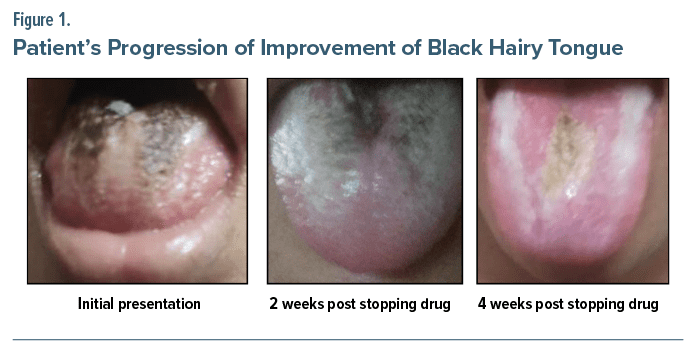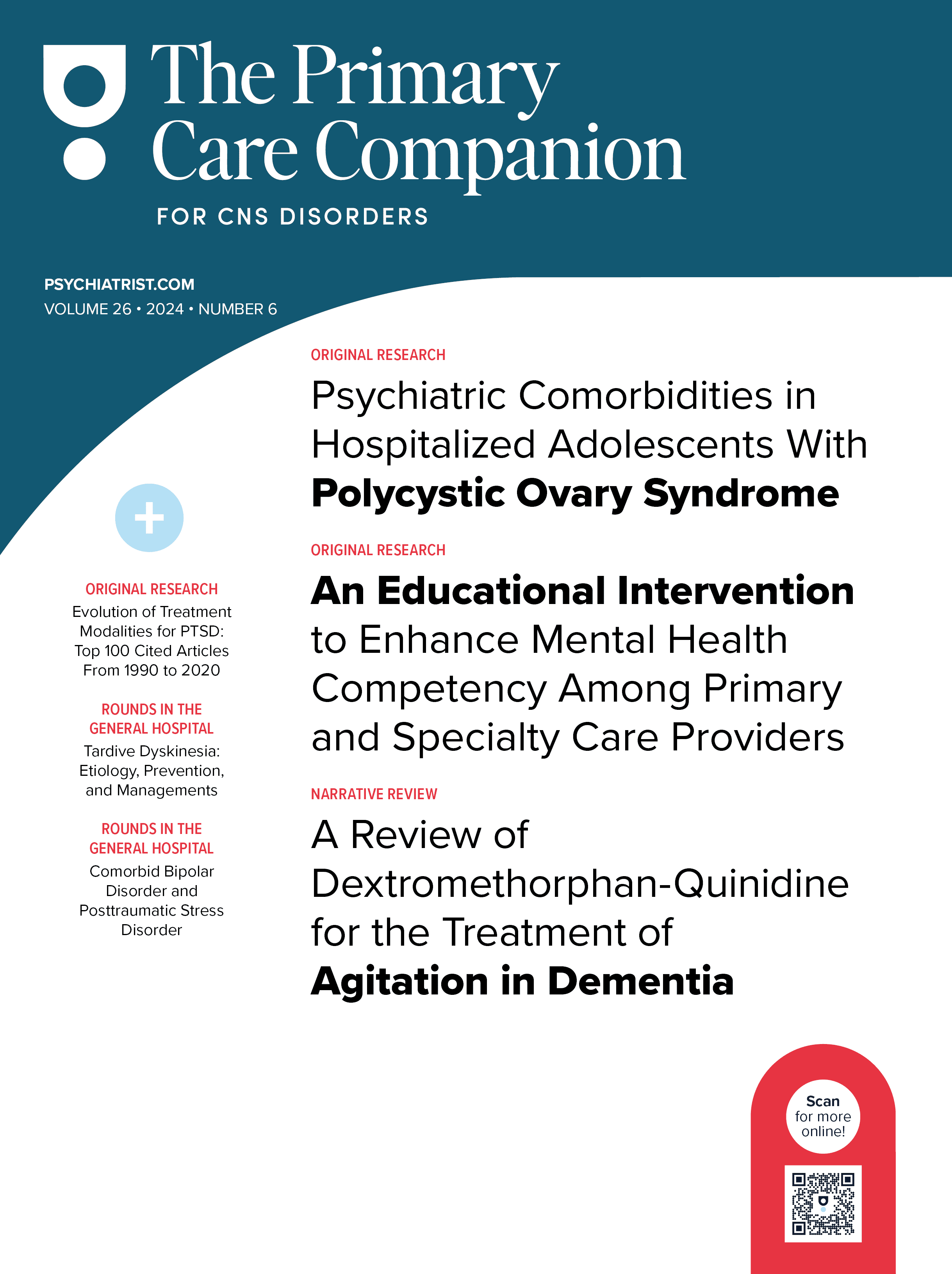Amatus Lusitanus first described “black hairy tongue” in 1557 as a painless, benign clinical condition characterized by defective desquamation and reactive hypertrophy of the filiform papillae of the tongue.1 Prevalence ranges from 0.6% to 11.3% and is 3 times more common in men than in women, with elderly males being more prone to development.2 Among the antipsychotic drugs, olanzapine is an atypical antipsychotic with a good safety profile that is frequently prescribed for severe mental disorders.3 While olanzapine is often linked to metabolic side effects, we report the case of a patient who developed black hairy tongue as a result of using the medication.
Case Report
A 23-year-old unmarried female college student of middle socioeconomic status was admitted to the psychiatry ward. The chief complaints were over talkativeness, over religiosity, decreased need for sleep, over familiarity, irritable affect, delusion of grandiosity, and assaultive behavior toward family members. Detailed workup was done, and neurological examination at that time was grossly normal with no focal deficits. There was no evidence of infection, and her blood sugar levels were within normal limits. The patient was diagnosed with manic episode, severe with psychotic symptoms (ICD-10 code F30.2) and was started on tablet olanzapine 5 mg once daily, uptitrated gradually to 20 mg over the course of 3 weeks. The Young Mania Rating Scale4 score at the time of admission was 42, which gradually decreased to 9 during her 3-week stay in the ward, and she was subsequently discharged.
At follow-up about 3 weeks later, it was noted that the patient developed a black discoloration on the dorsum of her tongue. Dermatology referral was made because of suspected fungal infection. She was prescribed tablet fluconazole 150 mg daily and clotrimazole 1% mouthwash for 10 days. However, the condition continued to worsen. There was no prior history of drug addiction, excessive coffee or tea use, or alcohol or tobacco use by the patient. She was only taking olanzapine. Physical examination revealed black hair-like projections on the dorsum of her tongue, with the tip and lateral sides as well as buccal mucosa and teeth appearing normal. The laboratory tests, including complete blood count, biochemical, and serologic tests, were within normal limits.
Potassium hydroxide mount was prepared from tongue scrapings to rule out fungal cause. Scrape cytology with May-Grunwald Giemsa stain showed abundant cellularity, excluding malignancy. Papanicolaou stain and periodic acid–Schiff stain revealed no malignancy or fungal bodies, and a sterile swab from the tongue patch was found. Olanzapine was discontinued, and lithium carbonate 900 mg was initiated after a prelithium workup. After 2 weeks, a decrease in the black tongue coating was observed, which disappeared a month later and remained absent during outpatient department follow ups, suggesting a possible link between olanzapine use and black hairy tongue development in this patient. Figure 1 shows the progression of improvement. The Naranjo Adverse Drug Reaction Probability Scale5 score was 8, which corresponds to a probable adverse drug reaction. The adverse drug reaction has been reported to the Pharmacovigilance Programme of India, with worldwide unique number IN IPC 201646573.
Discussion
Black hairy tongue is a condition triggered by various factors such as smoking, excessive coffee consumption, poor oral hygiene, trigeminal neuralgia, general debilitation, dry mouth, and certain drugs such as psychotropics (paroxetine, thiothixene hydrochloride, benztropine mesylate, clonazepam, and chlorpromazine), antibiotics, antihypertensives, and oxygenating oral mouth rinses.6 Management involves mechanical debridement, maintaining proper oral hygiene, and removing potential causative agents. Black hairy tongue usually resolves within days, but patient education on oral hygiene and lifestyle changes is crucial. Treatment options include 40% urea, salicylic acid, surgical excision, podophyllin, and tretinoin.7,8 Prevention involves smoking cessation and alcohol abstinence.2 The exact mechanism behind olanzapine induced black hairy tongue is unknown. It has been suggested that the anticholinergic properties of olanzapine may play a role in its development.9
Article Information
Published Online: October 3, 2024. https://doi.org/10.4088/PCC.24cr03757
© 2024 Physicians Postgraduate Press, Inc.
Prim Care Companion CNS Disord 2024;26(5):24cr03757
Submitted: April 11, 2024; accepted July 16, 2024.
To Cite: Dalal P, Pruthi T, Thakur MR, et al. Black hairy tongue: a rare adverse effect of olanzapine. Prim Care Companion CNS Disord. 2024;26(5):24cr03757.
Author Affiliation: Department of Psychiatry, Lady Hardinge Medical College and Smt. Sucheta Kriplani Hospital, New Delhi, India (all authors).
Corresponding Author: Manish R. Thakur, MD, Department of Psychiatry and Drug De-Addiction Centre, Lady Hardinge Medical College and Associated Hospitals, Shaheed Bhagat Singh Marg, Lady Hardinge Medical College, DIZ Area, Connaught Place, New Delhi 110001 ([email protected]).
Relevant Financial Relationships: None.
Funding/Support: None.
Patient Consent: Consent was received from the patient and the patient’s mother to publish the case report and photos. Information has been de-identified to protect anonymity.
ORCID: Manish R. Thakur: https://orcid.org/0000-0001-9427-3701
References (9)

- Thompson DF, Kessler TL. Drug-induced black hairy tongue. Pharmacotherapy. 2010;30(6):585–593. PubMed CrossRef
- Gurvits GE, Tan A. Black hairy tongue syndrome. World J Gastroenterol. 2014;20(31):10845–10850. PubMed CrossRef
- Gómez JC, Sacristán JA, Hernández J, et al. The safety of olanzapine compared with other antipsychotic drugs: results of an observational prospective study in patients with schizophrenia (EFESO Study). Pharmacoepidemiologic Study of Olanzapine in Schizophrenia. J Clin Psychiatry. 2000;61(5):335–343. PubMed
- Young RC, Biggs JT, Ziegler VE, et al. A rating scale for mania: reliability, validity, and sensitivity. Br J Psychiatry. 1978;133(5):429–435. PubMed CrossRef
- Naranjo CA, Busto U, Sellers EM, et al. A method for estimating the probability of adverse drug reactions. Clin Pharacol Ther. 1981;30:239–245. PubMed CrossRef
- Sarti GM, Haddy RI, Schaffer D, et al. Black hairy tongue. Am Fam Physician. 1990;41(6):1751–1755. PubMed
- McGregor JM, Hay RJ. Oral retinoids to treat black hairy tongue. Clin Exp Dermatol. 1993;18(3):291. PubMed CrossRef
- Langtry JA, Carr MM, Steele MC, et al. Topical tretinoin: a new treatment for black hairy tongue (lingua villosa nigra). Clin Exp Dermatol. 1992;17(3):163–164. PubMed CrossRef
- Kanodia S, Giri VP, Veerabhadrappa R, et al. Black hairy tongue with olanzapine: a rare case report. Indian J Psychiatry. 2017;59(2):249–250. PubMed CrossRef
Please sign in or purchase this PDF for $40.
Save
Cite


